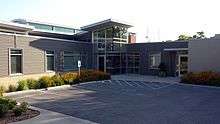KUAF
| City | Fayetteville, Arkansas |
|---|---|
| Broadcast area | Fayetteville and Fort Smith, Arkansas |
| Frequency | 91.3 MHz |
| First air date | 1973 |
| Format | Classical music/News talk |
| ERP | 100,000 watts |
| HAAT | 332.0 meters |
| Class | C0 |
| Facility ID | 4307 |
| Transmitter coordinates | 35°51′12.00″N 94°1′32.00″W / 35.8533333°N 94.0255556°W |
| Callsign meaning | University of Arkansas Fayetteville[1] |
| Affiliations | National Public Radio, American Public Media, Public Radio International, Public Radio Exchange |
| Owner | University of Arkansas |
| Website | http://www.kuaf.com |
KUAF (91.3 FM) is the flagship National Public Radio member station for northwest and western Arkansas, United States. The station is owned by the University of Arkansas, with studios near the school's campus in downtown Fayetteville. Its powerful 100,000-watt signal also serves Fort Smith as well. Most of the day, the station airs news programming, both locally produced and nationally syndicated from NPR, but classical music is aired during the mid-morning and overnight hours.[2]

KUAF began broadcasting in 1973 as a student-run station using a small transmitter on 88.9 FM[3] which sent a signal that reached most of the U of A campus and parts of surrounding Fayetteville. The station was supervised by a faculty member in the Department of Journalism at the University of Arkansas. Students studying radio, television, and film were given the opportunity to volunteer for various time slots available throughout the week. Aside from a few mandatory promos and songs, students were free to play whatever music was of interest to them. Many listeners referred to the station as "the 10-watt wonder". In 1985, KUAF joined the NPR network, giving western Arkansas its first NPR station. KUAF became the first station in its market to sign-on with an HD Radio signal in 2006.[4] While KUAF HD1 repeats the station's regular FM signal, KUAF HD2 broadcasts around-the-clock classical music from Classical 24, and KUAF HD3 broadcasts news and information programming from NPR, overnight world news from the BBC World Service, and programming from independent producers.[5]
References
- ↑ Nelson, Bob (2008-05-31). "Call Letter Origins". The Broadcast Archive. Archived from the original on 2016-02-18. Retrieved 2008-06-08.
- ↑ "KUAF Broadcast Schedule". KUAF 91.3 FM Program Guide. Retrieved 2013-10-09.
- ↑ "About". Retrieved 2017-11-09.
- ↑ "KUAF Goes HD". KUAF Goes HD: High Definition Means Better Sound, More Programs. Retrieved 2014-05-17.
- ↑ "KUAF HD3 Weekly Schedule". KUAF HD3 Program Guide. Retrieved 2014-05-17.
External links
- Query the FCC's FM station database for KUAF
- Radio-Locator information on KUAF
- Query Nielsen Audio's FM station database for KUAF

